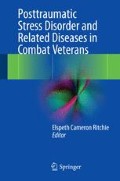Abstract
Symptoms of posttraumatic stress disorder (PTSD) and depression often fail to resolve with traditional interventions using psychotherapy and/or pharmacotherapy. Transcranial magnetic stimulation (TMS) is a noninvasive brain stimulation treatment that may offer efficacy for those patients who have not obtained adequate relief from their symptoms.
Access this chapter
Tax calculation will be finalised at checkout
Purchases are for personal use only
References
Taylor S. Clinician’s guide to PTSD: a cognitive-behavioral approach. New York: The Guilford Press; 2006.
Staeker J, Leucht S, Laika B, Steimer W Polymorphisms in serotonergic pathways influence the outcome of antidepressant therapy in psychiatric inpatients. Genet Test Mol Biomarkers. 2014;18(1):20–31.
Egan MF, Goldberg TE, Kolachana BS, et al. Effect of COMT Val108/158 Met genotype on frontal lobe function and risk for schizophrenia. Proc Natl Acad Sci U S A. 2001;98(12):6917–22.
Reynolds GP, Zhang ZJ, Zhang XB. Association of antipsychotic drug-induced weight gain with a 5-HT2C receptor gene polymorphism. Lancet. 2002;359(9323):2086–7.
Lencz T, Robinson DG, Napolitano B, et al. DRD2 promoter region variation predicts antipsychotic-induced weight gain in first episode schizophrenia. Pharmacogenet Genomics. 2010;20(9):569–72.
Zhang JP, Lencz T, Malhotra AK. D2 receptor genetic variation and clinical response to antipsychotic drug treatment: a meta-analysis. Am J Psychiatry. 2010;167(7):763–72.
Bhat S, Dao DT, Terrillion CE, et al. CACNA1C (Cav1.2) in the pathophysiology of psychiatric disease. Prog Neurobiol.2012;99(1):1–14.
Samer CF, Lorenzini KI, Rollason V, Daali Y, Desmeules JA. Applications of CYP450 testing in the clinical setting. Mol Diagn Ther. 2013;17(3):165–84.
Hoge CW, Castro CA, Messer SC, McGurk D, Cotting DI, Koffman RL. Combat duty in Iraq and Afghanistan, mental health problems and barriers to care. U.S. Army Med Dep J. 2008:7–17.
Hallett M. Transcranial magnetic stimulation: a primer. Neuron. 2007;55(2):187–99.
McCann UD, Kimbrell TA, Morgan CM, et al. Repetitive transcranial magnetic stimulation for posttraumatic stress disorder. Arch Gen Psychiatry. 1998;55(3):276–9.
Horvath JC, Perez JM, Forrow L, Fregni F, Pascual-Leone A Transcranial magnetic stimulation: a historical evaluation and future prognosis of therapeutically relevant ethical concerns. J Med Ethics. 2011;37(3):137–43.
Bolognini N, Ro T Transcranial magnetic stimulation: disrupting neural activity to alter and assess brain function. J Neurosci. 2010;30(29):9647–50.
Boggio PS, Rocha M, Oliveira MO, et al. Noninvasive brain stimulation with high-frequency and low-intensity repetitive transcranial magnetic stimulation treatment for posttraumatic stress disorder. J Clin Psychiatry. 2010;71(8):992–9.
Wassermann EM. Risk and safety of repetitive transcranial magnetic stimulation: report and suggested guidelines from the International Workshop on the Safety of Repetitive Transcranial Magnetic Stimulation, June 5–7, 1996. Electroencephalogr Clin Neurophysiol. 1998;108(1):1–16.
George MS, Raman R, Benedek DM, et al. A two-site pilot randomized 3 day trial of high dose left prefrontal repetitive transcranial magnetic stimulation (rTMS) for suicidal inpatients. Brain Stimul. May-Jun 2014;7(3):421–31.
Rossi S, De Capua A, Tavanti M, Calossi S, Polizzotto NR, Mantovani A, Falzarano V, Bossini L, Passero S, Bartalini S, Ulivelli M. Dysfunctions of cortical excitability in drug-naïve posttraumatic stress disorder patients. Biol Psychiatry. 2009;66(1):54–61.
Kim SY, Lee DW, Kim H, Bang E, Chae JH, Choe BY. Chronic repetitive transcranial magnetic stimulation enhances GABAergic and cholinergic metabolism in chronic unpredictable mild stress rat model: (1)H-NMR spectroscopy study at 11.7T. Neurosci Lett. 2014;572:32–7.
Karsen EF, Watts BV, Holtzheimer PE. Review of the effectiveness of transcranial magnetic stimulation for Posttraumatic stress disorder. Brain Stimul. 2014;7(2):151–7.
Group TMoP-TSW. VA/DoD Clinical practice guideline for management of Posttraumatic stress. In: Defense DoVAaDo, 2010.
Author information
Authors and Affiliations
Corresponding author
Editor information
Editors and Affiliations
Rights and permissions
Copyright information
© 2015 Springer International Publishing Switzerland
About this chapter
Cite this chapter
Grammer, G., Cole, J., Rall, C., Scacca, C. (2015). Use of Transcranial Magnetic Stimulation for the Treatment of PTSD. In: Ritchie, E. (eds) Posttraumatic Stress Disorder and Related Diseases in Combat Veterans. Springer, Cham. https://doi.org/10.1007/978-3-319-22985-0_11
Download citation
DOI: https://doi.org/10.1007/978-3-319-22985-0_11
Published:
Publisher Name: Springer, Cham
Print ISBN: 978-3-319-22984-3
Online ISBN: 978-3-319-22985-0
eBook Packages: MedicineMedicine (R0)

